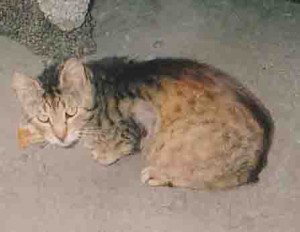Feline Immunodeficiency Virus and Feline AIDS
Bruno
My family called him Sick Kitty; I called him Bruno. He was scrawny and battered looking. His fur was drab and ratty, one ear had a chunk bitten off, and his nose was bloody. We thought he had been in a fight. With sad eyes, he warily watched the world around him. Little did we know he would stay and become one of the family.
We spoiled him with special tidbits of fried chicken and spoonfuls of wet cat food trying to fatten him up. The food appeared to make him better. He didn’t get any fatter, but his fur got shiny and his nose stopped bleeding.
After a couple of months, however, his bloody nose returned. Thinking he had a respiratory infection and needed antibiotics, we took him to the vet. Sadly, after running some tests, we discovered Bruno had the Feline Immunodeficiency Virus (FIV). In fact, the disease had progressed into Feline AIDS.
Tears ran down my cheeks. I had a friend with AIDS; I knew how destructive it could be for humans and suspected it wasn’t much different with cats. “Can we do anything for him?”
“Cats infected with FIV could lead normal lives when properly cared for,” our veterinarian, Dr. Conradi of Mt Scott Animal Clinic in Portland, Oregon, told us.
Dr. Conradi said that with lifestyle changes an infected cat could live for some time. Keeping FIV+ cats indoors, she explained, minimizes the risk of contracting other illnesses. However, other cats in the household must be considered when deciding whether to treat or euthanize. Are those cats healthy; are they old? Will they all get along together? If there are uninfected cats in the household, isolating the infected cat will help avoid possible transmission of the disease. We had two indoor cats and weren’t sure isolation would be possible
“In the USA, the general consensus is that three percent of the population is infected with FIV,” Dr. Conradi told us. Her office sees FIV often, “probably because Portland has a high number of outdoor cats, especially intact male cats.” She added that she’s been in practice for eleven years and although she hasn’t seen an increase in the disease, she hasn’t seen a decrease, either.
The virus is primarily transmitted through body fluids such as blood. The most susceptible felines are male strays as they are frequently aggressive and often fight with each other—most likely, the way Bruno contracted the disease. There is also a small risk of an infected female transmitting FIV to her litter through nursing.
FIV, like the Human Immunodeficiency Virus (HIV), attacks the feline’s immune system, weakening it and increasing the risk for infection, other illnesses, and eventually death. Although the two diseases are similar, an infected cat cannot pass FIV to its human companion.
The website www.essortment.com lists three stages of the disease: acute, latent, and chronic. It is in this third stage that FIV becomes Feline AIDS.
Symptoms vary in intensity within each stage. In the first stage, some cats may show no symptoms while others may display several. As the disease progresses through subsequent stages, the severity of the symptoms increases. As the disease worsens, the immune system weakens and is unable to fight off infections; the FIV+ cat’s death is usually a result from one of these infections.
It is important that you control fleas, worms, and mites infestation, therefore, since raw food may “include parasites and pathogens that a cat with a normal immune system might be able to handle but an FIV+ cat might not,” www.veterinarypartner.com cautions that you not feed your FIV+ cat raw foods. It adds that you continue appropriate vaccinations, and veterinarian check-ups.
The site also recommends not having a FIV+ cat in a household with an immune-suppressed owner, stating, “immune-suppressed cat can increase an immune-suppressed human’s exposure to infectious agents and vice versa.” We didn’t know this information until we read this article. I have rheumatoid arthritis and am on immune-suppressants, so keeping Bruno was not an option.
. “Vigilance and close monitoring of the health and behavior of FIV-infected cats is even more important than it is for uninfected cats,” says www.vet.cornell.edu. . It is important that you tell your veterinarian about any changes in your cat’s health as soon as possible. Although there isn’t a cure for FIV, there is treatment to control the symptoms. Medicines used to clear up infections and other illnesses are available just as they are for HIV.
“There are places that accept FIV-infected felines. Unfortunately, the ones nearby are full and not accepting more cats,” Dr. Conradi said.
After much discussion, we decided to euthanize Bruno. If there is no other way possible, I believe an infected cat should be put down. Euthanizing a seriously ill animal is a difficult decision, yet it is often the most logical and humane decision.
Before leaving the room, I reached into the kennel and caressed his side. “Good-bye, Bruno, I’m going to miss you.”
Who would have guessed this dirty, scrawny kitty would dig his way so deep into our lives. He wasn’t with us very long, yet he will always have a spot in our hearts.

